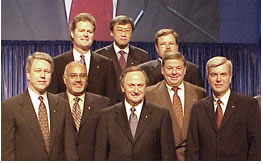
Separation of ARE into Two Parts
Resolution from floor offers help with National Energy Policy
Delegates to the 133rd AIA national convention voted to authorize an assessment of $50 per year per Architect member for three years (2002–2004) to extend the current AIA television advertising campaign. The assessment would be adjusted annually in the years 2003 and 2004 in an amount equivalent to the percentage change in the Consumer Price Index for the preceding 12-month period. The assessed funds would be used only for advertising or similar sponsorship or underwriting opportunities. The Institute will monitor the effectiveness of this effort and report results to the membership annually. The assessment authorization will expire after three years unless reauthorized by a vote of the delegates.
 Support
of educational and licensing standards
Support
of educational and licensing standards
Delegates passed a resolution sponsored by AIA Philadelphia supporting
educational and licensing standards. Per the resolution, the Institute
resolves to partner with institutions of higher education to encourage
active AIA participation in degree programs leading to licensure; work
toward creation of minimum acceptable standards first professional architectural
degrees, licensure, and AIA membership; and support offering of the licensing
exam—uniformly throughout the U.S.—to begin in the final semester
of any accredited first professional architectural degree program.
Through the resolution, the AIA supports the separation of the architectural licensing exam into two separate portions. Part 1 would test the academic knowledge of the graduate upon graduation. Part 2 would test the professional knowledge of the same individual after he or she has completed the intern development program.
Offer to Help with
National Energy Policy
Delegates also passed a resolution from the floor, titled "Design
and Energy Efficiency Initiative—Committee on the Environment,"
sponsored by the AIA Committee on the Environment, AIA Kansas City, and
AIA Seattle. The intent of the resolution is to delegate a committee selected
from the PIAs to help the national leaders develop the National Energy
Policy for Building Codes and Standards.
The resolution resolves that, "the AIA supports a program of national initiatives that will improve the energy efficiency, develop new alternative energy sources, and improve capital investment of our infrastructure and the preservation through good design and construction practices. It further resolves that "the AIA makes itself available to the President and the Congress of the United States of America to immediately assist in developing the architecture and urban design conservation standards to provide the American public with safe, efficient, and beautiful structures and the public realm while relieving stress on our energy supply related issues."
2001 Bylaws
Delegates also voted for bylaws amendments that allow components to prescribe
residency requirements for both regional directors and component officers.
A third bylaw maintains that the immediate past president of the Council
of Architectural Component Executives shall be included as a member of
the AIA Executive Committee, but shall have no voting rights on the Executive
Committee. (If that individual is unable or unwilling to serve, the Council
shall be represented by such other individual as the Council's Executive
Committee shall designate.)
Delegates defeated a proposed bylaws change that would have extended the terms of office for AIA vice presidents from one year to two years.
As is traditional, delegates offered to extend its
sincere appreciation to:
• The officers and members of the AIA Board of Directors who are
retiring at the end of 2001
• The host chapter and convention committees
• Convention committees
• Exhibitors
• John D. Anderson and Flodie Anderson.
Copyright 2001 The American Institute of Architects. All rights reserved.
![]()
|
To commence the May 19 AIA convention business meeting, 2001 President John Anderson introduced the 2002 AIA Executive Committee, including the newly elected first vice president, vice presidents, and treasurer. The 2002 officers, left to right: Top row, First Vice President Thompson E.Penney, FAIA; President Gordon H. Chong, FAIA; Vice President James A. Gatsch, AIA;. front row, Treasurer Douglas L. Steidl, FAIA; Secretary Stephan Castellanos, FAIA; EVP/CEO Norman L. Koonce, FAIA; Vice President Edward Kodet, FAIA; Vice President Eugene Hopkins, FAIA. |
|